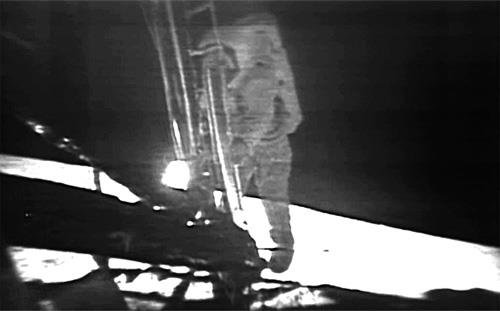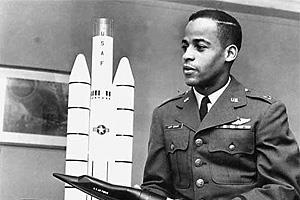
If television cameras had recorded King John signing the Magna Carta in 1215, it could not have looked much less primitive than the live television coverage of the 1969 Apollo moon landing.
The moment when Neil Armstrong became the first human to step on the lunar surface looked, frankly, like something out of a Bigfoot conspiracy video.
The July 20, 1969, footage did have this going for it, however: It was real. That’s why something like half a billion people gathered around TV sets to watch a moment that remains an exhilarating testament to what humans can do when they don’t waste so much of their energy fighting each other.
So it should surprise no one that television will spend many hours this month revisiting that event.
That also raises the ongoing question of whether those hours will start to feel like the same rerun in different packaging, or whether they will capture the excitement of that day and perhaps rekindle some of the spirit that fueled the long runup to the actual moon landing.
Three productions Sunday and Monday suggest that only the hardest core fanatics will want to watch every minute of every production.
If you’re being selective, the best bet from this bunch is PBS’s Chasing the Moon, a Robert Stone film that runs over three nights with fresh and engaging material that feels admiring yet not worshipful.
Herewith these early-round choices:
 Apollo: Mission to the Moon (Nat Geo, Sunday, 9 p.m. ET). This is a just-the-facts-ma’am report, meticulously tracking the Apollo program from start to finish. Twelve years, 12 missions, the most famous of which was of course Apollo 11, the moon landing.
Apollo: Mission to the Moon (Nat Geo, Sunday, 9 p.m. ET). This is a just-the-facts-ma’am report, meticulously tracking the Apollo program from start to finish. Twelve years, 12 missions, the most famous of which was of course Apollo 11, the moon landing.
Nat Geo does this documentary right, sticking entirely to archival footage with no re-creations or extended narration. It draws on some of the famous reports by CBS News anchor Walter Cronkite and numerous other sources, including newsreels and archival footage from the National Aeronautics and Space Administration (NASA) itself. It also includes fresh interviews.
Nat Geo reminds us that our space program was kick-started by the Russian space program, the first to send a satellite into orbit and the first to send an astronaut into space and return him safely.
This Russian victory felt as if it reset the whole balance of technology in the Cold War, and not, for America, in a good way.
At the same time, this positions America’s subsequent recovery to feel even sweeter, like a come-from-behind victory in a ballgame.
Mission to the Moon doesn’t ignore the cost, notably the 1967 capsule fire that killed three astronauts, but in general it presents a march to triumph.
The engineers and designers are dedicated, the astronauts are rugged pioneers and America cheers them over the finish line.
In the show’s key scene, we follow Apollo 11 in real time as it descends and touches down, then watch Armstrong and Buzz Aldrin carefully back down the exit ladder in their bulky white suits.
It’s as close as TV will come to recapturing the magic of the moment. It also adds poignance to the last minutes of the show, when we see subsequent astronauts zipping over the moon’s surface in their Lunar Rover while we’re reminded that once Project Apollo ended, so did moon exploration for what everyone knew would be many decades.

The Day We Landed on the Moon (Smithsonian, Sunday, 9 p.m. ET). Smithsonian gives us, in effect, a guided tour of July 20, 1969.
Using artifacts from the Smithsonian itself, plus commentary from relevant witnesses, this documentary makes the moon landing less abstract and more concrete.
Here as in a museum, artifacts and equipment are used to connect viewers, ideally with the physical reality of flying to the moon and stepping onto its dusty surface.
For those who suspect museum trips can feel somewhat dry, Smithsonian brings in interviews with recognizable celebs, including Queen guitarist Brian May – who is also a total space geek.
Still, The Day We Landed on the Moonis more education than entertainment.
 Most moon shows essentially celebrate the wonderfulness of the lunar landing and the Apollo program. While Chasing the Moon director Robert Stone doesn’t argue with that, (PBS, Monday-Wednesday, 9 p.m. ET), he makes an ongoing point of reminding us that the enterprise had its dark and shady undersides.
Most moon shows essentially celebrate the wonderfulness of the lunar landing and the Apollo program. While Chasing the Moon director Robert Stone doesn’t argue with that, (PBS, Monday-Wednesday, 9 p.m. ET), he makes an ongoing point of reminding us that the enterprise had its dark and shady undersides.
Mission Control was located in Houston, for instance, because Albert Thomas, the congressman who represented that district, held a crucial key to NASA funding.
While that’s business as usual in Washington, it effectively reminds the viewer that not everyone thought only in terms of soaring human achievement.
Stone also takes time to address a point that’s visually glaring in every moon landing documentary: Pretty much everyone involved, from the astronauts to the decision-makers to the control panel crew, is a middle-aged white man.
Stone details how one black military man, Edward Dwight, entered the preliminary astronaut training program, and was led to expect he would be selected as part of a mission crew.
 He was fully qualified, and NASA went so far as to circulate his picture in Africa, where the agency had critical tracking stations, as a way of suggesting to insurgents on that restless continent that any damage to tracking stations could put a black man in danger.
He was fully qualified, and NASA went so far as to circulate his picture in Africa, where the agency had critical tracking stations, as a way of suggesting to insurgents on that restless continent that any damage to tracking stations could put a black man in danger.
In the end, Dwight was not selected, and the awkward press conference at which he is asked to address his rejection speaks volumes about 1960s America. When astronaut Deke Slayton is asked whether any “Negro” candidates had been among the finalists for that round of astronauts, he says no.
And speaking of the candidates who were selected, most other moon landing shows faithfully adhere to their public personae as all-American, straight-arrow good guys straight out of a Hollywood movie.
In fact, a former NASA public relations man notes here, the agency on multiple occasions had to suppress stories about the conduct of their guys, because the truth could hurt morale and the image of Apollo.
Stone isn’t the first to suggest the Apollo team had a healthy share of competitive egos and senses of entitlement. Stone just chooses to poke into that side of the story, less to diminish the men than to remind us we’re talking about humans here, not Marvel heroes.
As perfect a triumph as the moon landing itself might still feel, Stone reminds us it was carried out by us imperfect people, and that it came with costs and calculations. To underscore that point, he begins his film by recounting the urgent U.S. push at the end of World War II to recruit Nazi scientists. The most famous of that group, Dr. Werner Von Braun, became the lead rocket scientist on Project Apollo.
Chasing the Moonranks as a first-rate documentary that captures the urgent, troubling and exultant sides of the Apollo mission. The 1960s was a roller coaster of wars, assassinations and stunning achievements, and Stone crams his six hours full of footage that brings it all to life.